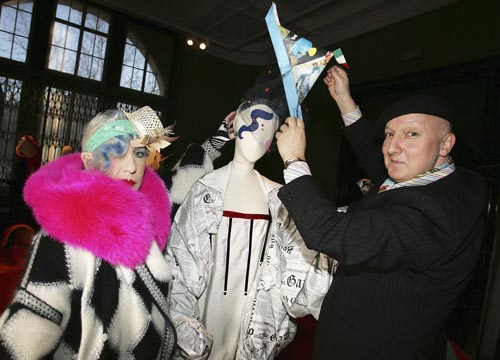- 阅读
- 阅读
- 技巧
- 百科
- 试题
- 文化
- 技能
Anna Piaggi, Fashion Editor With a Keen Eye for Trends, Dies at 81
“行走的时装博物馆”去世
ANNA PIAGGI, an oracular Italian fashion editor known for an endless array of eye-popping, wildly colorful outfits of the most peculiar combinations, ranging from vintage Patou to thermal mountain rescue coats to a uniform vest from late-period McDonald’s, died Tuesday at her home in Milan. She was 81.
谜一样的意大利时尚编辑安娜·皮亚姬(Anna Piaggi)周二在她米兰的家中去世,享年81岁。她以其独特的着装闻名,这些服装的色彩之绚丽,搭配之怪异,让人瞠目结舌,从老式的巴杜(Patou)服装,到山地保暖救援外套,到麦当劳的马夹工装,层出不穷。
Her death was confirmed by Italian Vogue, where Ms. Piaggi had created some of her most visually arresting and influential work.
意大利版《Vogue》杂志证实了她的死讯。她最惹人注目、最有影响力的一些作品是在这本杂志创作的。

Owing to her vast knowledge of fashion history, as well as a personal wardrobe that included clothes spanning more than 200 years, Ms. Piaggi was often described as “the walking museum.” Manolo Blahnik, who designed many of her shoes, once described her as “the only authority on frocks left in the world.”
她在时尚历史方面的知识非常广博,她个人衣橱里的服装时间跨度超过200年,所以她被称为“行走的博物馆”。莫罗·伯拉尼克(Manolo Blahnik) 给她设计过很多鞋子,曾经形容她是“世界上仅存的连衣裙专家”。
She was an eccentric editor in the mode of Diana Vreeland. (“My pets are my hats,” she would say.) But she was more often compared to the Marchesa Luisa Casati for her unbridled, theatrical awe-inspiring sense of dress. During a career that spanned more than five decades, Ms. Piaggi became as much a symbol of the embrace of high-fashion exuberance as the young and wild designers that she championed. She was a muse to many of them, most famously to Karl Lagerfeld during a particularly glamorous period of his success in Paris, in the 1960s and 1970s.
皮亚姬是个戴安娜·弗里兰(Diana Vreeland)范儿的怪编辑。(“我的宠物是我的帽子,”她这样说。)但是鉴于她对服装无拘无束的、戏剧般的、令人敬畏的敏感,人们更多地拿她跟玛切萨·路易莎·卡萨蒂(Marchesa Luisa Casati)比较。在皮亚姬50多年的职业生涯中,她成为把握各种时装潮流的象征,看到她就想到她所支持的那些年轻、狂野的设计师。他们中的很多人视她为缪斯,其中最出名的是20世纪六七十年代在巴黎处于事业辉煌时期的卡尔·拉格菲尔德(Karl Lagerfeld)。
As captured in Alicia Drake’s book “The Beautiful Fall,” Ms. Piaggi “was outstanding in her devotion to creating style.” Traveling with Mr. Lagerfeld and his entourage, she would bring several trunks of clothing for a weekend: “vintage haute couture, antique jodhpurs from Chelsea Market, Edwardian bloomers that she had dyed jet black and a canvas cape that had begun life as a costume in Les Ballets Russes’s first production of Stravinsky’s ‘Firebird.’ ”
艾利西亚·德雷克(Alicia Drake)在《美丽的陨落》(The Beautiful Fall)一书中写道,皮亚姬“非常热衷于引领时尚”。跟拉格菲尔德以及他的随员周末出游,她就能带上几箱衣服:“老式的高级订制时装,切尔西市场的老式骑马裤,被她染成深黑色的爱德华七世时期的灯笼裤,还有一种用于装饰的帆布披肩,起源于俄罗斯芭蕾舞团第一次演出斯特拉文斯基的《火鸟》时的戏服。”
Editors and photographers routinely waited for Ms. Piaggi to make an entrance at fashion shows, where she could be relied upon to create a spectacle, unless she was wearing an especially large hat. Then, she would watch the show from backstage, so as not to obstruct anyone else’s view.
在时装发布会上,编辑和摄影师一般都会等皮亚姬入场,因为她一定会是个看点——除非因为她戴了一顶超级大的帽子,这时为了不挡住其他人的视野,她就只能在后台看表演。
Nevertheless, her appearance was unmistakable: the white-powdered face highlighted by a dollop of bright rouge painted on each cheek, eyes ringed in blue or black shadow, lips painted with an exaggerated cupid’s bow and, often, a miniature clown’s hat (usually by Stephen Jones) perched askew on her wave of blue hair. Ms. Piaggi claimed that she had not left home without a hat since the early 1980s.
尽管如此,更显眼的还是她的外表:脸上扑着白粉,两颊上涂着两团鲜艳的腮红,眼帘上描着蓝色或黑色的眼影,嘴唇涂成夸张的丘比特之弓形状,蓝色卷发上歪歪地倚着一顶微型的小丑帽(通常是斯蒂芬·琼斯[Stephen Jones]的作品)。皮亚姬声称从20世纪80年代早期以来,她从未不带帽子就出门。
“I feel better if I have a good hat on,” she said.
“戴上一顶好帽子,能让我放松很多,”她说。
A 2006 exhibition dedicated to her style, at the Victoria and Albert Museum in London, drew 4,000 visitors a week. The show opened with an accounting of her wardrobe: 265 pairs of shoes, 29 fans, 932 hats, 2,865 dresses, 24 aprons and 31 feather boas.
2006年在伦敦的“维多利亚和阿尔伯特”博物馆举办了一场向皮亚姬着装风格致敬的展览,一周吸引了4000名观众。这次展览的物品全部来自她的衣橱:265双鞋子,29把扇子,932顶帽子,2865件裙子,24件围裙和31条羽毛围巾。
Ms. Piaggi was born in 1931 in Milan, according to Italian Vogue. In a 2004 profile in The Observer in London, she said that her father, who was a manager and buyer for the department store la Rinascente, died when she was 7. Her upbringing, she said, was a bit conventional, “but it didn’t last very long.”
据意大利版《Vogue》杂志说,皮亚姬1931年出生于米兰。在伦敦《观察家》2004年的一篇人物侧写中,她说自己的父亲是文艺复兴(la Rinascente)百货商店的经理和买手,她7岁的时候,父亲去世了。她的家庭教育有点传统,她说,“但是这种保守的态度持续的时间并不长。”
While working as an interpreter at a press agency in the 1950s, she met the photographer Alfa Castaldi, who was a major contributor to Italian Vogue and who introduced her to the profession of fashion magazines. They were married in 1962 and worked together until Mr. Castaldi’s death in 1995.
20世纪50年代,她在一个通讯社做译员的时候,遇到了摄影师阿尔法·卡斯塔迪(Alfa Castaldi)。意大利版《Vogue》杂志的很多照片都出自阿尔法之手。他把皮亚姬带入了时尚杂志行业。他们1962年结婚并一起工作,直到1995年卡斯塔迪去世。
Scouting stores in London, Ms. Piaggi became acquainted with Vern Lambert, a fashion historian and a major dealer of vintage clothes, whom she credited with sparking her interest in collecting. When she met Mr. Lagerfeld, who was designing for Chloé, at his home in Paris, she happened to be wearing an important dress by Ossie Clark, which Mr. Lagerfeld immediately recognized. He began sketching her outfits over many years, and published a book of them.
在伦敦的商店里搜罗服装的时候,皮亚姬跟弗恩·兰伯特(Vern Lambert)混熟了。兰伯特是一个时尚历史学家和古董衣的经销商。她说是他激发了自己收藏服装的兴趣。她第一次见到拉格菲尔德,是在他巴黎的家里,那时拉格菲尔德在给品牌Chloé做设计。那天,她正好穿着奥西·克拉克(Ossie Clark)设计的一件很有影响力的连衣裙作品,拉格菲尔德一眼就认出来了。他开始给她画服装素描,画了很多年,最后还结集出版。
From 1981 to 1983, Ms. Piaggi was the editor in chief of Vanity, a magazine that developed a cultlike following. Many covers were illustrated by Antonio Lopez.
从1981年到1983年,皮亚姬是《Vanity》杂志 的主编,后来人们对那本杂志的追捧,达到了疯狂的地步。杂志的很多封面都是安东尼奥·洛佩斯(Antonio Lopez)绘制的。
When Franca Sozzani became the editor of Italian Vogue in 1988, she said she wanted to create a magazine that was very quick at spotting trends, and hired Ms. Piaggi as a creative consultant. There she created free-form collages that often connected the unseen dots between fashion and cultural trends. The regular feature, called Doppie Pagine (or “double pages,” or just “D.P.”), established a template for modern trend reporting by juxtaposing images of classical references with the current season’s runway designs.
弗兰卡·索扎妮(Franca Sozzani)1988年成为意大利版《 Vogue》杂志的编辑时,她说自己想做一本能快速捕捉时尚热点的杂志,所以聘请皮亚姬做创意顾问。在那里,皮亚姬把时装和文化潮流之间建立起联系。她爱使用一种所谓跨页版式,就是把当季T台上的设计与其参考的传统服装的图片并列放在一起,这成了现代时尚报道的延用模板。
As Ms. Piaggi described them in “Anna Piaggi’s Fashion Algebra,” a collection of her columns published in 1998, her double pages “have been for me like a dress taking shape.” For her style, Ms. Piaggi was named to the International Best Dressed List numerous times and was inducted into its Hall of Fame in 2007.
皮亚姬在1998年出版的专栏文集《安娜·皮亚姬的时尚逻辑》中说,跨页设计“对我来说,像是连衣裙成了型”。由于着装风格独特,皮亚姬多次入选“全球最佳着装榜”,并在2007年被列入“最佳着装名人堂”。
“She dresses the way one plays a role,” Mr. Lagerfeld once said. “She’s a great performer, but she is also the author of the play.”
参与评论